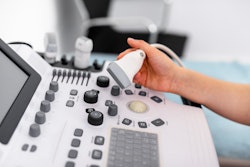Lung ultrasound underdiagnoses clinically significant pneumothorax, suggest findings published September 20 in Surgery.
Researchers led by Jarrett Santorelli, MD, from the University of California, San Diego found that ultrasound on initial trauma evaluation has low sensitivity and a high rate of false-negative exams.
“Because many of these false-negative results are clinically significant requiring thoracostomy, using chest ultrasonography alone to screen for pneumothorax should be done with caution,” Santorelli and colleagues wrote.
While chest CT remains the gold standard for diagnosing traumatic pneumothorax, supine chest x-ray and lung ultrasound are also used for rapid confirmation or exclusion of this injury during initial resuscitation. However, with advancements in ultrasound technology over the years, some reports suggest that the modality’s performance rivals that of chest x-ray. Still, ultrasound’s reliability in this area is unclear.
Santorelli and co-authors in their study put lung ultrasound to the test, using it as an initial screening tool for pneumothorax and comparing the results with supine chest x-ray.
The analysis included data from 1,489 patients who underwent ultrasound, x-ray, and confirmatory CT. Of the patients; of these, 71.4% were male, average age was 42 years, and average injury severity score was 6. Also, 80 patients presented with pneumothorax as confirmed by admission CT imaging.
Lung ultrasound demonstrated lower sensitivity but comparable sensitivity when pitted against chest x-ray.
| Performance of lung ultrasound, chest x-ray in diagnosing pneumothorax | ||
|---|---|---|
| Measure | Supine chest x-ray | Lung ultrasound |
| Sensitivity (including occult cases) | 46.3% | 27.5% |
| Specificity (including occult cases) | 99.5% | 99.5% |
| Sensitivity (excluding occult cases) | 62.2% | 46.7% |
| Sensitivity (excluding occult cases) | 99.5% | 99.5% |
Lung ultrasound also had a false-negative rate of 72%, with 22% of patients with false negatives undergoing tube thoracostomy. Chest x-ray had a false-negative rate of 53%, with 20% undergoing the procedure.
Finally, the team compared false-negative and true-positive lung ultrasound results. It found that the false-negative group showed a significantly smaller median pneumothorax size (13 mm) than that of the true-positive group (25 mm; p = 0.01). The group found similar results from the chest x-ray exams.
Based on their findings, the study authors recommend that ultrasound and chest x-ray be used as adjuncts to chest CT in this area. They also recommended that clinicians exercise caution if they choose to rely on sonography alone as a screening tool for detecting traumatic pneumothorax.
“It may be useful to use these tests [ultrasound and x-ray] in conjunction as we observed the combined sensitivity and specificity, if either test is positive, to significantly increase to 71.1% and 99.4%, respectively,” the authors wrote.
The full results can be found here.



















